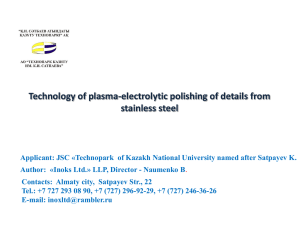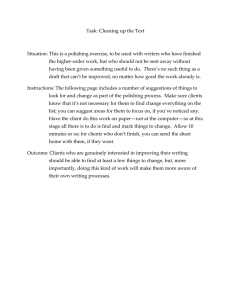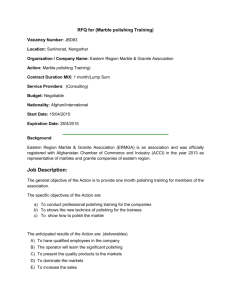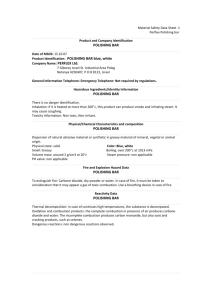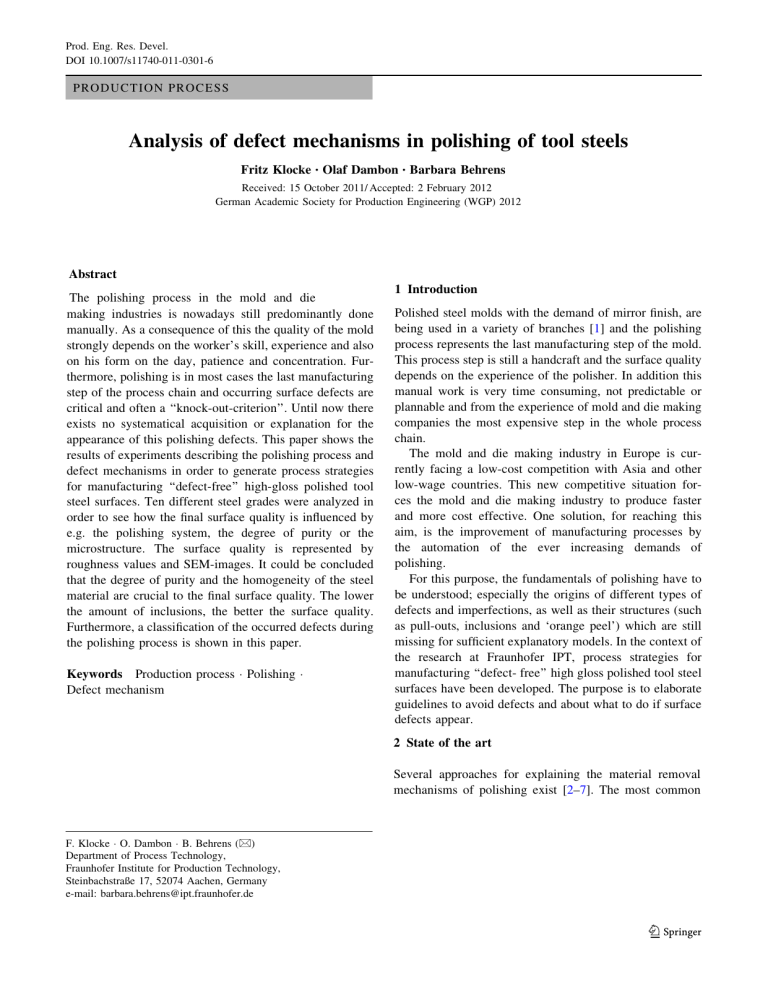
Prod. Eng. Res. Devel. DOI 10.1007/s11740-011-0301-6 PRODUCTION PROCESS Analysis of defect mechanisms in polishing of tool steels Fritz Klocke • Olaf Dambon • Barbara Behrens Received: 15 October 2011/ Accepted: 2 February 2012 German Academic Society for Production Engineering (WGP) 2012 Abstract The polishing process in the mold and die making industries is nowadays still predominantly done manually. As a consequence of this the quality of the mold strongly depends on the worker’s skill, experience and also on his form on the day, patience and concentration. Furthermore, polishing is in most cases the last manufacturing step of the process chain and occurring surface defects are critical and often a ‘‘knock-out-criterion’’. Until now there exists no systematical acquisition or explanation for the appearance of this polishing defects. This paper shows the results of experiments describing the polishing process and defect mechanisms in order to generate process strategies for manufacturing ‘‘defect-free’’ high-gloss polished tool steel surfaces. Ten different steel grades were analyzed in order to see how the final surface quality is influenced by e.g. the polishing system, the degree of purity or the microstructure. The surface quality is represented by roughness values and SEM-images. It could be concluded that the degree of purity and the homogeneity of the steel material are crucial to the final surface quality. The lower the amount of inclusions, the better the surface quality. Furthermore, a classification of the occurred defects during the polishing process is shown in this paper. Keywords Production process Polishing Defect mechanism 1 Introduction Polished steel molds with the demand of mirror finish, are being used in a variety of branches [1] and the polishing process represents the last manufacturing step of the mold. This process step is still a handcraft and the surface quality depends on the experience of the polisher. In addition this manual work is very time consuming, not predictable or plannable and from the experience of mold and die making companies the most expensive step in the whole process chain. The mold and die making industry in Europe is currently facing a low-cost competition with Asia and other low-wage countries. This new competitive situation forces the mold and die making industry to produce faster and more cost effective. One solution, for reaching this aim, is the improvement of manufacturing processes by the automation of the ever increasing demands of polishing. For this purpose, the fundamentals of polishing have to be understood; especially the origins of different types of defects and imperfections, as well as their structures (such as pull-outs, inclusions and ‘orange peel’) which are still missing for sufficient explanatory models. In the context of the research at Fraunhofer IPT, process strategies for manufacturing ‘‘defect- free’’ high gloss polished tool steel surfaces have been developed. The purpose is to elaborate guidelines to avoid defects and about what to do if surface defects appear. 2 State of the art Several approaches for explaining the material removal mechanisms of polishing exist [2–7]. The most common F. Klocke O. Dambon B. Behrens (&) Department of Process Technology, Fraunhofer Institute for Production Technology, Steinbachstraße 17, 52074 Aachen, Germany e-mail: barbara.behrens@ipt.fraunhofer.de 123 Prod. Eng. Res. Devel. models for steel can be summarized into three main hypotheses (Fig. 1). The Abrasion Hypothesis describes the removal mechanism as an abrasive process. Roughly speaking this mechanism is similar to the grinding process but employing very small grains. Since the abrasive particles in the polishing fluid are much smaller than the grains during the grinding process and only temporary bound in the soft polishing tool, the roughness is smaller and the surface smoother. In the Flow Hypothesis it is assumed that the peaks of roughness are driven or melt into the valleys of the surface because of local pressure and temperature peaks. By this process a smoothing of the surface is achieved. The Chemical Hypothesis is based on the theory that during the polishing process chemical reactions between the boundary layer of the workpiece and the polishing suspension proceed. The polishing process can be an interaction of these 3 hypotheses, so that mechanical and chemical influences are responsible for the removal rate and the surface quality of a Fig. 1 Removal mechanisms in steel polishing [8] Fig. 2 Influencing parameters during the polishing process [10] 123 polished sample. They describe the removal rate during the polishing process, respectively the appearing interactions, but give no exact quantitative characterization for the removal rate. For this purpose several empirical process models exist. The most common model for the prediction of the removal rate is the Preston Hypothesis [9]. dz ¼ K P p vR dt This equation shows that the removal rate (dz/dt) is proportional to pressure and relative velocity and the constant Kp named the Preston Constant. Kp includes all chemical and mechanical interactions between tool and boundary layer of the workpiece. p is the pressure per unit area, v is the velocity between polishing tool and sample and dz/dt is the rate of material removed (cutting depth per unit time). If on the one hand the equation is simple, but on the other hand the coefficient Kp is difficult to determine. There are a lot of different parameters which interact Prod. Eng. Res. Devel. during the polishing process. Figure 2 gives a short overview of these parameters. In addition it is a fact that during polishing of steel with diamond slurry the removal rate is dominated by the abrasion hypothesis [8]. 2.1 Removal behavior of tool steels From other publications [10, 11] it is known, that the hardness of the steel is an important influencing parameter. The softer the steel, the lower the removal rate and the higher the roughness values. This behavior can be explained because of the steel’s ductility. During the polishing process plastic deformation processes cause a displacement of the material but no removal. This is why the energy input for softer steel grades is higher and the removal rate lower, as the polishing process starts with a deformation of the soft material until the abrasive process starts. 2.2 Interaction between the polished steel surface and polishing abrasives At the polishing system ‘‘steel and diamond suspension’’, the material is removed in the area between the steel surface and the polishing grain. The hard polishing grain gets into the workpiece surface and removes material from the surface. This abrasive removal process can be described by a model from Zum Gahr [12]. Four different interactions between the abrasive particles and the material are described in this model (Fig. 3). Microploughing shows that the polishing grain after getting in contact with the surface, pushes the loosened material along, which finally agglomerates at the sides of the groove. Ideally no material is removed with the micro ploughing. But if more and more polishing grains get to the same area, the material is again and again pushed to the sides, until it breaks out. This phenomena is called microfatigue. During the microcutting the grain gets deep into the material and due to the maximum forming ability of the material a chip is formed, which matches in the best case to the groove. Microcracking is the result of high tensions, which are put into the material from the abrasive particles. This mechanism exists at brittle materials (e.g. ceramics), while microcutting and microploughing mainly appear at ductile materials (e.g. steel). According to [8] it can be said that during the polishing process of hardened steel the mechanism of microcutting is dominant, while microploughing appears during the polishing of soft steel structures. Regarding the achievement of high surface qualities, the mechanism of microcutting should be preferred, since the material is cut off far cleaner from the surface. In contrast to this, during the microploughing the roughness value even raises because of the accumulated material at the side of the grooves. Despite of many experiments in the field of steel polishing, the reason of appearance of imperfections is still not clear and logical explanatory models for describing them are missing. This research work starts on the basis of this knowledge with the goal to analyze and explain the defect mechanisms in polishing of tool steels. 3 Experimental setup The polishing experiments were accomplished with two different polishing machines. The first machine (Fig. 4) is a polishing head Microploughing Microcutting sample holder (up to 6 samples) platen display & control (force, rpm, time) Microfatigue Microcracking Fig. 3 Different interactions between abrasive and steel surface [12] Fig. 4 Table polishing machine for finishing of plane samples 123 Prod. Eng. Res. Devel. Fig. 5 Manual polishing device (left) and a selection of common polishing tools (right) sand paper brass & plastic (SiC) ring felt ring standard grinding and polishing machine for metallographic applications—a Phoenix 4000 V/1 by Buehler GmbH. This machine is able to polish up to six plane samples simultaneously. The polishing head rotates at a constant rate of 150 min-1, while the rotational speed of the polishing disk can be varied between 50 and 600 min-1. During the experiments the rotational speed of the polishing disk was constant set to 150 min-1. The second machine, which was used to gain knowledge of the manual work of a polisher, was a manual polishing system JOKEÒ Ergo-Work from JOKEÒ (Joisten & Kettenbaum, Fig. 5 left). The manual polishing can be realized by different hand pieces, brass or plastic rings, lapping stones, polishing pads and several diamond pastes for polishing with rotational or translational tool movement (Fig. 5 right). The samples were evaluated visually with a light microscope to get a good overview of the whole surface of the samples and scanned with a SEM (scanning electron microscope) to get a closer view on defects. Additionally, measurements with a white light interferometer were accomplished to provide a detailed overview of the surface and roughness parameters, e.g. Sa and Sz (arithmetical mean height and maximum height of the surface) [13]. Ten different tool steels were analyzed (Table 1), of which nine are commonly used in the mold and die making industry for gloss and mirror finish. Although one steel grade (1.2379) is no typical polishable steel, it was analyzed on purpose, in order to clearly see the influence of different composition. The four bold marked steel grades will be discussed further in this paper as a discussion of all examined steel grades would blast the extend of this text. 123 Table 1 Examined tool steels Material no. Abbreviation (DIN) 1.2083 X40Cr14 1.2311 40CrMnMo7 1.2316 X36CrMo17 1.2343 X38CrMoV5-1 1.2343mod. X35CrMoV5-1 1.2367 X38CrMoV5-3 1.2379 X153CrMoV12 1.2738 40CrMnNiMo 8.6.4 1.2738mod. 26MnCrNiMo 6.5.4 1.2767 X45NiCrMo4 4 Results and discussion The main focus of the experiments was the surface quality, which is discussed in the following chapters in correlation to different influencing factors. 4.1 Influence of the steel composition and microstructure The measured values and SEM images were compared to the composition and microstructure of the different steel grades in order to find correlations to the polishing results. To keep track of the results, four chosen steel grades (bold in Table 1) polished with the table polishing machine are shown in the pictures below. As can be seen in Fig. 6, the 1.2379 steel has the highest roughness and well defined inclusions (Fig. 7). The explanation for this is the high carbon content which leads to many hard and large primary carbides in the basic matrix Prod. Eng. Res. Devel. Fig. 6 Roughness of polished tool steels Fig. 7 Chromium carbides of the steel grade 1.2379 Fig. 8 Material structure contrast—etching with 3% Nital (see Fig. 7, left) and in the following polishing process to pull-outs. Steel 1.2379 has a high chromium content which was added for corrosion resistance, but as chromium has a high affinity to carbon, this results in chromium carbides, which can be seen in the results from the EDX (energy dispersive x-ray)-analysis in Fig. 7, right. Despite low roughness values (Fig. 6), the 1.2083 steel also includes chromium carbides in its material structure. Because of the lower carbon content than 1.2379, the amount of the carbides is not that high and therefore the polished surface quality improves. Concerning the steel grades 1.2343 mod. and 1.2367 there is no clear evidence for the influence of the steel composition. Here the polishing results are more effected by the microstructure. As can be seen in Fig. 8, 1.2343 mod. has an optimal martensitic structure, while 1.2367 shows, despite a martensitic structure, dense segregations with primary carbides. These segregations are the reason for higher roughness, as they tend to break out during the polishing process. 4.2 Influence of the steel manufacturing process The second experiment focused on the manufacturing process of steel. Only one steel grade—1.2343—remelted with four different methods, was analyzed. The first steel was open melted in an electric arc furnace without any remelting afterwards. The second one was remelted with the Electro Slag Remelting (ESR) method. According to this remelting procedure the carbide precipitations and the non-metallic inclusions (NMI) are minimized. An even more homogenous material is achieved with the third remelting method, the Pressure Electro Slag Remelting (PESR). The difference to the ESR technique is 123 Prod. Eng. Res. Devel. Fig. 9 Roughness of polished samples of 1.2343 with different degrees of purity that the steel is remelted among an inert gas atmosphere, which minimizes the NMI (especially the oxides) in the steel material. The forth remelting method included in the study was the Vacuum Arc Remelting (VAR), which is done under vacuum to reduce the content of gases, e.g. oxygen and nitrogen. All samples were manually polished and tested for their degree of purity–represented in the K0/K1 values in order to find a correlation between the roughness values and the K0 and K1 value [14]. The K-value gives information about the amount of the surface ratio of the non-metallic inclusions. The smaller the number behind the letter K, the more ‘‘small inclusions’’ were considered for the measurement (according to special tables). K0 is the most accurate K-value determination, which is used for vacuum remelted steels. Figure 9 shows the roughness Sa and Sz of the polished samples. It is clear that the roughness is low for all four manufacturing processes. Compared to the degree of purity (Table 2) a distinct correlation can be stated; the better the degree of purity, the lower the roughness. But this statement is only valid for the average roughness. Studying the statistical spread, the difference of the roughness is not definitely given. In contrary to the missing clarity of the correlation between purity and roughness, the visual evaluation of the samples by light microscope and SEM prove an important difference between the surface quality. While the VAR polished steel seems to have almost no defects, the ESR remelted steel and the open melted steel possess many NMI. With help of a MATLAB tool, it was possible to count the defects (even very small ones up to two pixels) and display the total area of the defects in histograms (Fig. 10). The histograms in Fig. 10 are based on 15 light microscope pictures per sample. In these diagrams, it can be seen that the VAR steel exhibits the lowest amount of defects, while the open melted steel shows more than 2,000 small defects. These results give new questions to metrology, since it is assumed that the roughness parameters are not sufficient to characterize surface defects (also pointed out in e.g. [15] and [16]). 123 Table 2 Comparison of the results of the purity values K0 and K1 with roughness parameters Sa and Sz (Steel 1.2343) K0 K1 Sa Sz Open 2.3 0.8 1.8 17.8 ESR 6.3 2.1 2.1 21.8 PESR 1.0 0 1.8 19.7 VAR 0.9 0 1.9 17.9 4.3 Classification of surface imperfections This leads to another important aspect, which is the classification of surface defects. The challenge is to find a common and precise vocabulary to classify the defects. As a first step towards an uniform polishing vocabulary, a defect chart was created on the basis of the European standard EN ISO 8785 [17]. A similar topic for microcomponents was already analyzed at the institute for metrology, automation and quality science (BIMAQ) [18], where the detection of imperfections with different types of metrology characterization methods was the focus. This defect chart (Fig. 11) concentrates only on high gloss polished tool steels and the occurring defects during the polishing process. A couple of the defects presented in Fig. 11 are discussed in more detail below. Orange-peel can be described as many flat gaps side by side whereby an effect of an orange-peel (or like an irregular pattern of a golf ball) occurs. It often appears after too long polishing times, if too high pressures are applied and/or if too soft or wrong sized polishing tools are used. Thus, since this defect seems to be an aspect of the chosen polishing technique rather than a material problem, the knowledge of and experience in polishing strategies are vital to avoid ‘‘over-polishing’’. Waviness belongs to the form deviations (DIN 4760) [20] and is defined as the deviation of the original geometry in the range of mm–lm. It often appears during the manual polishing because of non-uniform pressure distribution. The consequence of the appearance is a high post-processing effort. It can only be avoided if the pressure Prod. Eng. Res. Devel. 2500 1500 ESR Number of defects open Number of defects Fig. 10 Histograms of counted defects on polished samples of 1.2343 with different degrees of purity 2000 1500 1000 500 0 0 0.5 1 1.5 Area 2 2.5 1000 500 0 3 0 0.5 1 1.5 2 2.5 1000 200 Number of defects VAR 800 600 400 200 0 0 0.5 1 1.5 2 2.5 Area 50 0 3 0 0.5 Local imperfections on the surface affect wide areas Pitting 500 100 1 1.5 2.5 3 Form deviations Grooves 1500 2 Area [µm2] Defects which 0 150 [µm2] 2500 µm 0 0 40 80 120 Edge effects 160 µm 0 500 40 1500 300 nm 2000 µm Line 1000 Comet Tails 20 nm 80 120 µm Sa = 28 nm Sz = 138 nm Cracks Waviness nm 86 0 94 µm 500 µm Scratches 0 200 400 600 0 400 30 nm 600 µm Relief 1000 2000 Spot 200 400 0 124,0 µm 3000 µm 0 200 400 600 800 µm 0 0 200 400 600 400 Peak 0 20 40 60 800 µm 200 400 nm 600 µm 0 - 61 Corrosion Holes/Pull-Outs 800 µm 200 0 ISO 8785:1998 Other 0 1200 nm 600 µm Burnmarks 80 µm 500 20 1000 50 nm 1500 40 2000 100 nm 60 µm µm Orange Peel 0 0 1000 2000 3000 µm 500 1000 1500 2000 150 nm Appearance Number of defects PESR Fig. 11 Classification of surface imperfections [19] 3 Area [µm2] [µm2] Discoloration Haze 2500 µm 123 Prod. Eng. Res. Devel. Fig. 12 Interactions with diamond grain and steel surface [8] distribution is even, which in turn requires a great experience in manual polishing. The difference between scratches and grooves is the direction of the tracks. Scratches have no specific direction since they appear because of the polishing (e.g. diamond) grains. Grooves are directed, often deep, and in most cases formed during the previous preparation steps (e.g. grinding or turning). Scratches are an inherent effect of the mechanical polishing and occur if high pressure or wrong tools have been used. The polishing grain gets into the surface and pulls a track behind itself. The smaller the polishing grain, the softer the tool and the lower the pressure, the smoother the scratch and so the surface roughness. Pull-outs might be the most interesting defects, as they appear as peaks on injection molded plastic parts and are the reason for rejects, which may lead to judicial issues between polisher, mold maker, steel manufacturer and end user. Pull-outs occur, as the name indicates, when carbides or non-metallic inclusions are pulled out of the steel matrix. Five different scenarios are imaginable for the interaction between a diamond grain and a steel matrix containing carbides (see Fig. 12); 1. A typical mechanical abrasion of steel caused by a diamond grain (no carbide particles involved), 2. A diamond grain strikes a large primary carbide, which stays in the surface as it is still enclosed by the steel matrix, 123 1 2 3 4&5 3. Secondary carbides, which are smaller than the diamond grain, are removed from the steel matrix and will not affect the surface quality, 4. and 5. Carbides having the same size as the diamond grain, or are even larger, are not easily removed out of the steel matrix, but will be cut into pieces or pulled-out by the diamond grain. The last scenario is generating the undesirable defects on mirror finished surfaces; spread over larger areas, i.e. scattered pull-outs, commonly known as pitting. Another reason for pull-outs are non-metallic inclusions (NMI), e.g. oxidic and/or sulphidic particles occurring as line shaped or globular inclusions. NMI can, as the carbides, break out and leave holes or stay in the steel matrix, but in some cases only the softer material around the NMI is removed leaving a ‘‘stuffed hole’’ with the disadvantage that water can enter, ending up in corrosions around actual inclusion. On basis of this defect table and the according manifold experiments, polishing strategies for various examined steel grades were formulated and will be presented on the SFB/TR4 homepage. 5 Conclusions and future research For the technological experiments of polishing tool steels, different influencing factors were considered. In this Prod. Eng. Res. Devel. publication the influences of steel composition, microstructure and steel manufacturing process (degree of purity) on the polishing quality were shown. It can be concluded that the following factors are important for the polishing result: The steel composition, especially the carbon and chromium content. On the contrary small differences in the alloying elements such as manganese, molybdenum and vanadium have no effect to the polishing result. The microstructure of the steel—to achieve a mirror finished surface, a homogenous microstructure (without segregations) is required. The choice of the manufacturing process, since it controls the purity level and the amount of non-metallic inclusions in the material. The ‘‘impurities’’ in the steel matrix can not be completely avoided, only minimized with special process routes and manufacturing processes of the steels. Further it can be concluded that roughness measurements alone can not fully describe the surface quality of a high gloss polished steel surface. Parallel to the development of new and automated polishing systems, new surface analysis methods are required to get more accurate and objective surface quality controls. The classification table of surface imperfections provides a first common vocabulary of the polishing process. The results of all influencing factors are finally summarized to polishing strategies for generating defect free surfaces. These strategies will help the polisher to avoid defects and to save time. Furthermore these strategies can be transferred to a robot cell with an integrated forcecontrolled polishing spindle in order to automate the polishing process [21, 22]. Acknowledgments The investigations presented in this paper were carried out within the research project SFB/TR4-T3 ‘‘Development of Process Strategies for the Manufacturing of Defect Free Surfaces for the Polishing of Tool Steels’’ funded by the German Research Association, Deutsche Forschungsgemeinschaft (DFG). References 1. Altan T et al (1993) Advanced techniques for die and mould manufacturing. Ann CIRP 42/2:707–716 2. Aghan RL, Samuels LE (1970) Mechanisms of abrasive polishing. Wear 16:293–301 3. Hambücker S (2001) Technologie der Politur sphärischer Optiken mit Hilfe der Synchrospeed-Kinematik, Dissertation RWTH Aachen, S. 47, 88, 103–105 4. Horne DF (1972) Optical production technology. Adam Hilger Ltd., Bristol, pp 9–17 5. Klocke F, Hambücker S, Dambon O (2002) Influence exerted by the pad material and polishing suspension on reproducibility of a polishing process, production engineering. Ann Ger Acad Soc Prod Eng, vol 9, No.2, pp 51–54 6. Klocke F, Dambon O, Zunke R (2008) Modeling of contact behavior between polishing pad and workpiece surface, production engineering. Ann Ger Acad Soc Prod Eng vol 2, No.1 7. Denkena B, Lütjens G, Böß V (2003) Feinbearbeitung von Werkzeugen und Formen. Automatisiertes Schleifen und Bandschleifen von Freiformflächen im Praxiseinsatz. Wt Werkstattstechnik online H. 11. www.werkstattstechnik.de/wt/2003/ 11/03.htm. S 729–734 8. Dambon O (2005) Das Polieren von Stahl für den Werkzeug- und Formenbau. Dissertation, RWTH Aachen, Shaker Verlag 9. Preston FW (1927) The theory and design of plate glass polishing machines. J Soc Glass Technol, vol 11 10. Klocke F, Dambon O, Schneider U (1994) Polieren von Stahl für den präzisen Werkzeugbau, wt Werkstattstechnik online, S.71–75 11. Dambon O et al (2006) Surface interactions in steel polishing for the precision tool making. Ann CIRP 55/1 12. Zum Gahr K-H (1987) Microstructure and wear of materials, tribology series 10, Elsevier Science, Amsterdam 13. Deutsches Institut für Normung (2008) DIN EN ISO 25178: Oberflächenbeschaffenheit: Flächenhaft—Teil 2: Begriffe und Oberflächen-Kenngrößen 14. Deutsches Institut für Normung (1985) DIN 50602: metallographic examination; microscopic examination of special steels using standard diagrams to assess the content of non-metallic inclusions 15. Rebeggiani S (2009) Polishability of tool steels—characterisation of high gloss polished tool steels, Licentiate Thesis (No. 45), Chalmers University of Technology, Sweden 16. Pessoles X, Tournier C (2009) Automatic polishing process of plastic injection molds on a 5-axis milling center. J Mat Process Technol 209:3665–3673 17. Deutsches Institut für Normung e.V. (1999) DIN EN ISO 8785: Geometrische Produktspezifikationen (GPS)—Oberflächenunvollkommenheiten 18. Scholz-Reiter B, Lütjen M, Lübke K, Thamer H, Hildebrandt T.(2010) Klassifikation von Oberflächenunvollkommenheiten in der Mikrokaltumformung, ZWF–Zeitschrift für wirtschaftlichen Fabrikbetrieb 1–2, S 42–46 19. Behrens B, Zunke R (2010) Mehr als Fingerspitzengefühl, Zeitschrift Werkzeug und Formenbau Ausgabe 4, p 52–53 20. Deutsches Institut für Normung (1982) DIN 4760: Gestaltabweichungen 21. Klocke F, Brecher C, Zunke R, Tücks R, Zymla C, Driemeyer Wilbert A (2010) Hochglänzende Freiformflächen aus Stahlwerkzeugen, wt Werkstattstechnik online, Jahrgang 10, Heft 6 22. Brecher C, Wenzel C, Tuecks R (2008) Development of a force controlled polishing tool, Proceedings of the 10th euspen International Conference, Zurich, vol I, pp 438–442 123
